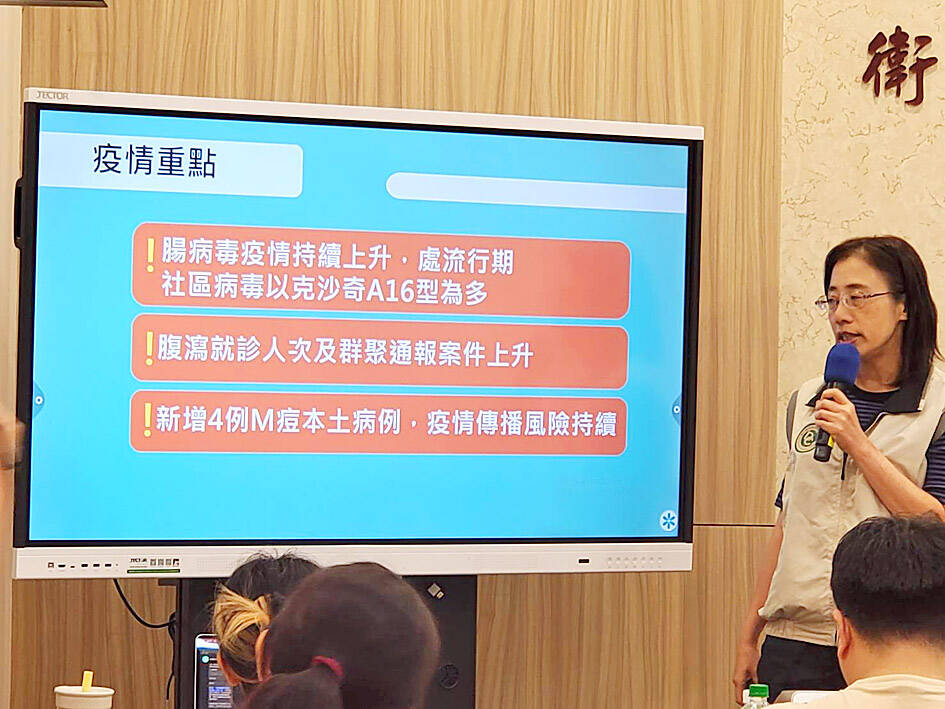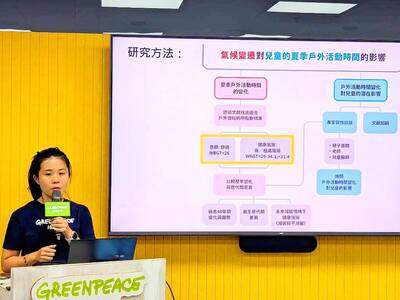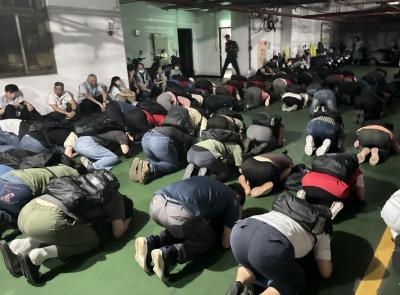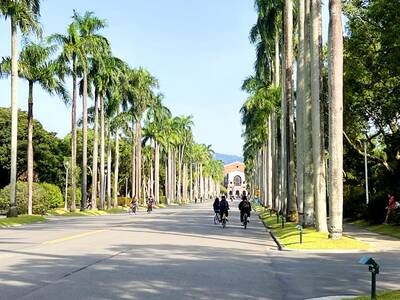There were 129,536 hospital visits for diarrhea last week and cases are expected to continue increasing until after the Mid-Autumn Festival, the Centers for Disease Control (CDC) said yesterday.
CDC Epidemic Intelligence Center Deputy Director Lee Chia-lin (李佳琳) said 129,536 hospital visits for diarrhea were reported last week, an increase of 1.3 percent from the previous week, and the number has been increasing for five consecutive weeks.
A total of 98 clusters of diarrhea cases were reported in the past four weeks, the most in the same period in five years, with most of the clusters reported at restaurants and hotels, she said.

Photo: Lin Hui-chin, Taipei Times
Among 48 clusters of which the pathogens had been identified, 29 clusters (60.4 percent) were caused by norovirus, followed by 14 clusters (29.2 percent) caused by the bacterium Vibrio parahaemolyticus, CDC data showed.
CDC Deputy Director-General Philip Lo (羅一鈞) said the current wave of diarrhea seems “fierce” and the number of norovirus infections was also higher than previous years, so people should pay attention to food hygiene when barbecuing, and cook meat and seafood thoroughly.
Diarrhea cases often peak near the Mid-Autumn Festival, as many people barbecue and feast in groups, he said, adding that cases might begin to drop after the holiday.
The CDC said common symptoms of viral or bacterial gastroenteritis include nausea, vomiting, diarrhea, abdominal pain and fever, adding that it sometimes also causes bloody or purulent stool.
The symptoms can last from one to 10 days, and the duration differs according to the pathogen and the person’s immunity, while children younger than six years, elderly people and immunocompromised people might have more serious symptoms, it said.
People should wash their hands with soap after using the restroom and before preparing and eating food, it said.
People should maintain a clean and hygienic kitchen environment, avoid cross-contamination of raw and cooked food, and avoid keeping refrigerated food at room temperature for too long, it said.
Meanwhile, Lee said enterovirus infections remain in the epidemic state, as 14,279 hospital visits were reported last week, an increase of 2.4 percent from the previous week, and the highest of the same week in five years.
In addition, Lo said as the government-funded seasonal flu and COVID-19 vaccination program begins on Oct. 1, an online vaccination consent form would be available for parents so that their children can get vaccinated.
CDC Division of Preparedness and Emerging Infectious Disease Deputy Director Chih Yi-chien (池宜倩) said parents need to scan a QR code provided by their child’s school to access the online platform and fill in the data.
If parents need to make changes after signing the consent form, they need to scan the QR code and fill in the form again, and those who do not want to use the online system can ask for a paper form from schools, she said.
If a child has a condition preventing them from getting vaccinated on the day of on-campus vaccination, parents can ask for a vaccination notice from the school and take their children to a healthcare facility to get them vaccinated later, she said.
Lo said there are five brands of vaccines available for the government-funded flu vaccination program this year, and local health departments would arrange the details, including the brands of vaccines and dates, with schools.
The five types of vaccines have obtained the Food and Drug Administration’s approval, he added.

The government should improve children’s outdoor spaces and accelerate carbon reduction programs, as the risk of heat-related injury due to high summer temperatures rises each year, Greenpeace told a news conference yesterday. Greenpeace examined summer temperatures in Taipei, New Taipei City, Taoyuan, Hsinchu City, Taichung, Tainan and Kaohsiung to determine the effects of high temperatures and climate change on children’s outdoor activities, citing data garnered by China Medical University, which defines a wet-bulb globe temperature (WBGT) of 29°C or higher as posing the risk of heat-related injury. According to the Central Weather Administration, WBGT, commonly referred to as the heat index, estimates

Taipei and other northern cities are to host air-raid drills from 1:30pm to 2pm tomorrow as part of urban resilience drills held alongside the Han Kuang exercises, Taiwan’s largest annual military exercises. Taipei, New Taipei City, Keelung, Taoyuan, Yilan County, Hsinchu City and Hsinchu County are to hold the annual Wanan air defense exercise tomorrow, following similar drills held in central and southern Taiwan yesterday and today respectively. The Taipei Mass Rapid Transit (MRT) and Maokong Gondola are to run as usual, although stations and passenger parking lots would have an “entry only, no exit” policy once air raid sirens sound, Taipei

Taipei placed 14th in the Quacquarelli Symonds (QS) Best Student Cities 2026 list, its highest ever, according to results released yesterday. With an overall score of 89.1, the city climbed 12 places from the previous year, surpassing its previous best ranking of 17th in 2019. Taipei is “one of Asia’s leading higher-education hubs,” with strong employer activity scores and students “enjoying their experience of the city and often keen to stay after graduation,” a QS staff writer said. In addition to Taipei, Hsinchu (71st), Tainan (92nd), Taichung (113th) and Taoyuan (130th) also made QS’ list of the top 150 student cities. Hsinchu showed the

Environmental groups yesterday filed an appeal with the Executive Yuan, seeking to revoke the environmental impact assessment (EIA) conditionally approved in February for the Hsieh-ho Power Plant’s planned fourth liquefied natural gas (LNG) receiving station off the coast of Keelung. The appeal was filed jointly by the Protect Waimushan Seashore Action Group, the Wild at Heart Legal Defense Association and the Keelung City Taiwan Head Cultural Association, which together held a news conference outside the Executive Yuan in Taipei. Explaining the reasons for the appeal, Wang Hsing-chih (王醒之) of the Protect Waimushan Seashore Action Group said that the EIA failed to address